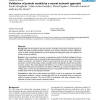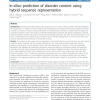48 search results - page 6 / 10 » Protein structural class prediction based on an improved sta... |
BMCBI
2008
13 years 7 months ago
2008
Background: The development and improvement of reliable computational methods designed to evaluate the quality of protein models is relevant in the context of protein structure re...
BMCBI
2007
13 years 7 months ago
2007
Background: Relating features of protein sequences to structural hinges is important for identifying domain boundaries, understanding structure-function relationships, and designi...
APBC
2004
13 years 9 months ago
2004
Transcription factors play essential role in the gene regulation in higher organisms, binding to multiple target sequences and regulating multiple genes in a complex manner. In or...
BMCBI
2011
12 years 11 months ago
2011
Background: Intrinsically disordered proteins play important roles in various cellular activities and their prevalence was implicated in a number of human diseases. The knowledge ...
BMCBI
2006
13 years 7 months ago
2006
Background: Multiple sequence alignment is the foundation of many important applications in bioinformatics that aim at detecting functionally important regions, predicting protein...



